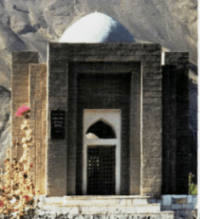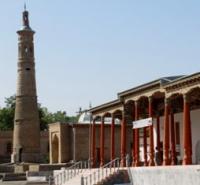Вы здесь
Hazrati-Shoh mausoleum.


Visiting places of interest Istaravshan.
“Ancient aphorisms outlived centuries. Modern aphorisms can barеly survive from book to book”
Ljupka Cvetanova.
Travel services in Istaravshan.
The historical-architectural complex known under nameHazrati-Shoh, is in an old part of the city of Istaravshan and consists of three cult constructions:
Mausoleum Hazrati-Shoh,
Mausoleum Hudoer Valami,
Mosques Hazrati-Shoh (also known and as mosque Namazgoh).
Mausoleum Hazrati-Shoh a building consisting of two domes, construstion in XVIII century, local residents considers a place of a burial place as a tomb of the cousin of prophet Muhammada Kusama ibn - Abbas.
Before a building of the mausoleum there is a spring which water is sacred and medical. On a legend, the spring was formed after imam Ali has lowered the staff in high-mountainous lake Oikul (lake Oidinkul in, the Turkestani ridge) which has appeared at legs buried in Ur-Tyube Hazrati-Shoh where there was a spring.
Long before an establishment of an islam the spring was considered at local population sacred as a source of a life. Subsequently, after acceptance of Moslem, near to a spring there was a burial of the esteemed religious figure (tomb).
Later above its tomb the simple mausoleum - single-chamber over a grave a construction which then has been transformed in two-chamber has been constructed, and is attached G-a figurative corridor even later.
In XVII - XVIII centuries to the mausoleum the canopy with wooden columns has been attached. According to early Islamic views, above a tomb of a devout moslem there should ot be no constructions, and even prophet Muhammad bequeathed to bury itself in that place where he will die, without erection over a graveо monument.
Nevertheless, there are facts of deviation from religious views. Scientists consider, that construction of the mausoleums is connected with saved in people and after acceptance of an islam by ceremonies and rituals of the ancient religions cultivated constructions of temples of fire, a various sort of sanctuaries.
In this connection the certain interest is represented with a find made in 1940, in a funeral crypt near tomb. Here female burials were revealed some. One of bodies, was embalm internal bodies have been removed from it, then the belly cavity and a cavity of a basin are filled by a fabric impregnated by special preparations.
Means of embalming were so strong, that a mummy and even a shroud in which she has been covered, have not given in to decomposition, despite of bad conditions for safety. The Found out mummy represents the big scientific interest from the point of view of methods of opening, means and ways of embalming, and the fact of its find speaks about a significant level of development in medieval Central Asia of knowledge in the field of medicine and chemistry.
In the past near to the mausoleum were a city cemetery, madrasah, korikhona and nagorkhona. According to archives, at the mausoleum in six rooms lived 12 readers of the Koran (reproach), constantly praying for repose a shower deceased which have found last haven on a cemetery of governors of Ur-Tyube adjoining to a construction.
Authorship:
The Tourist guidebook on monuments of Tajikistan. 2012.







